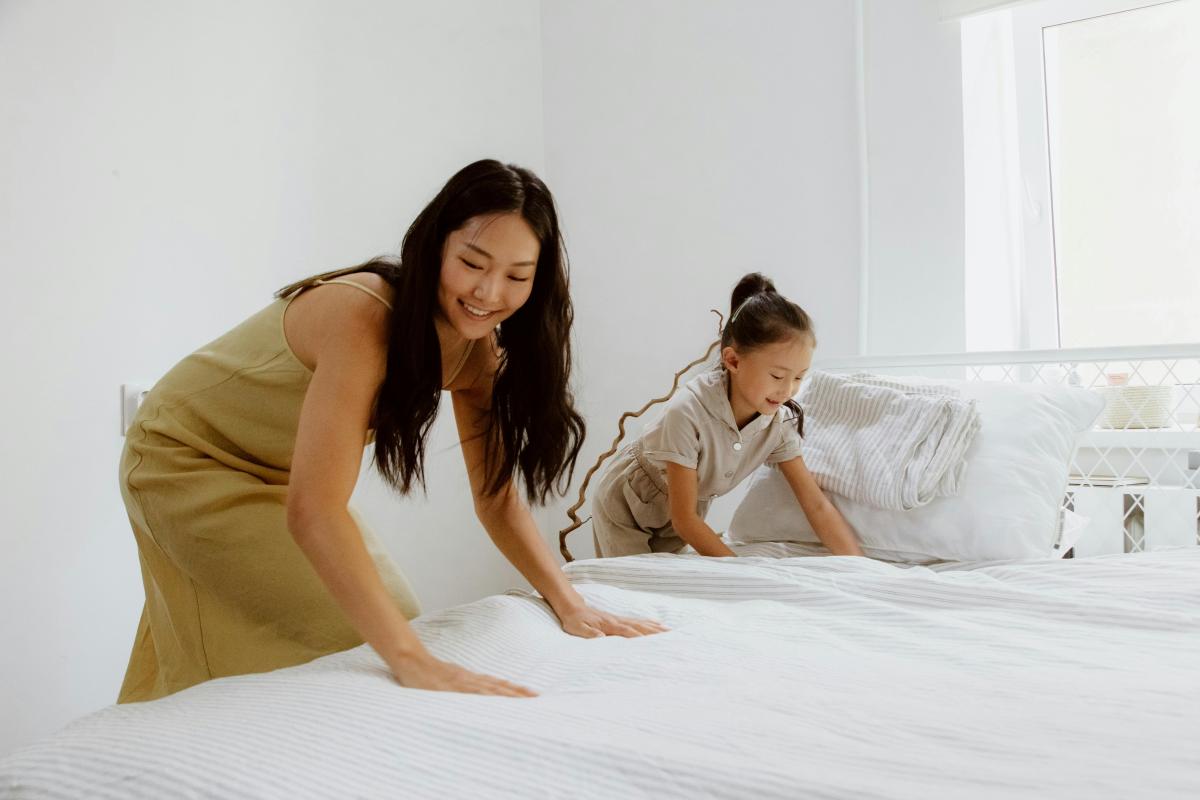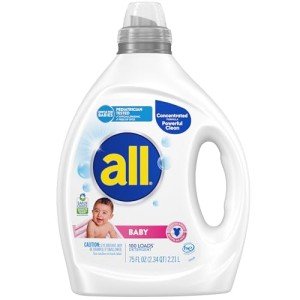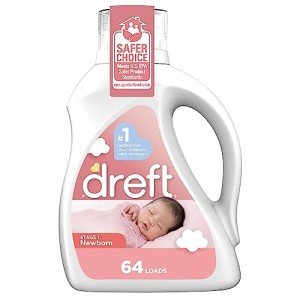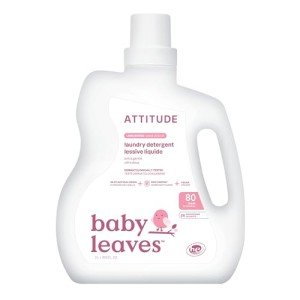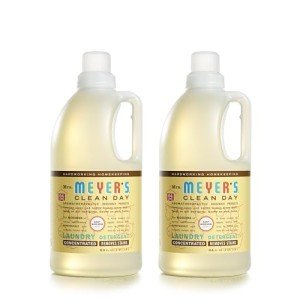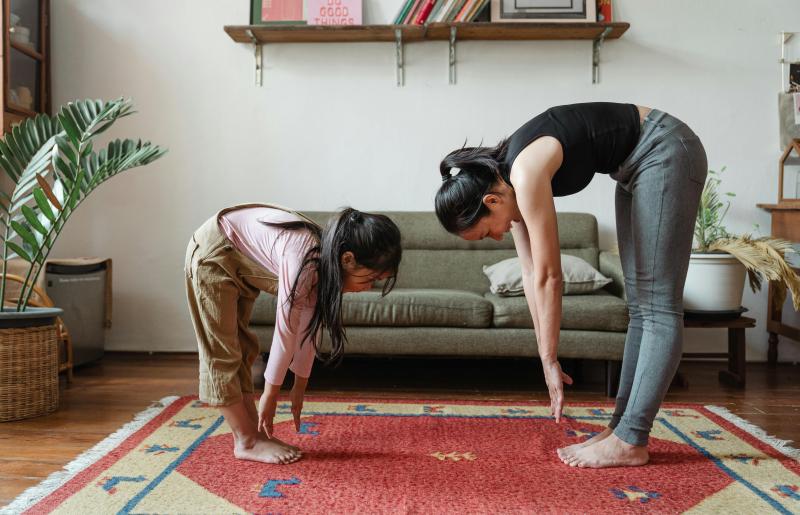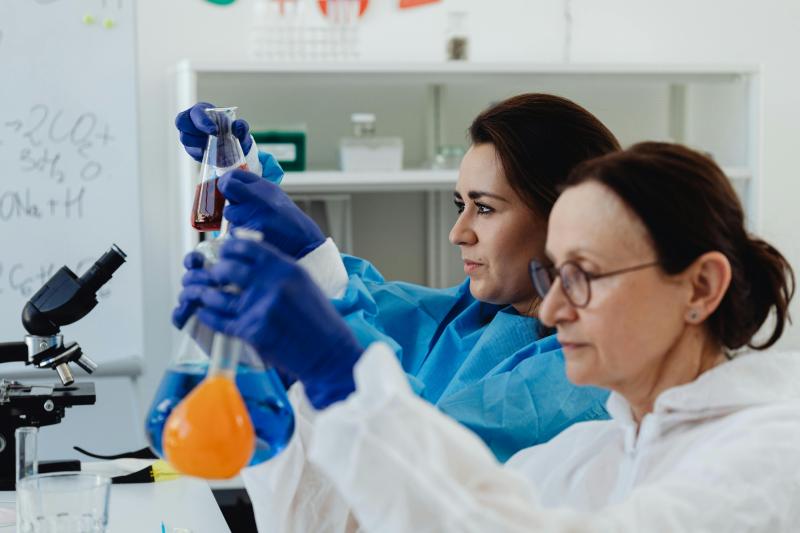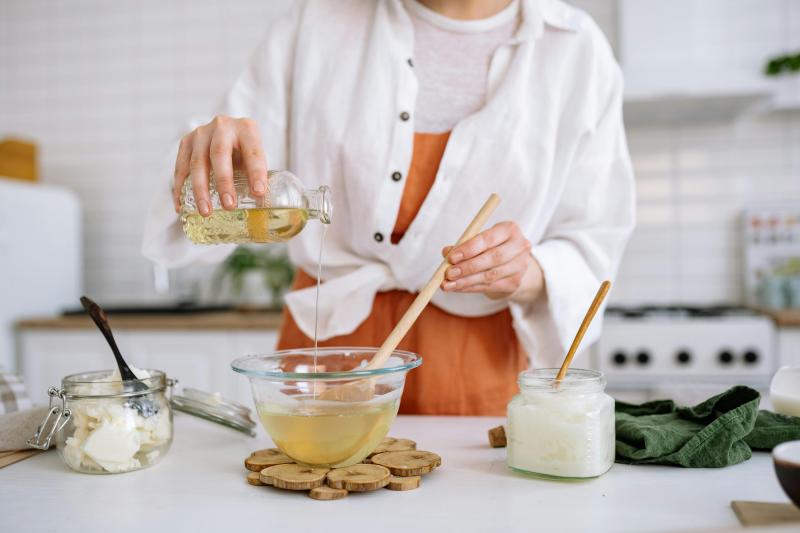|
BY JONATHAN ESSARY · June 23, 2025 |
|
READ EST: 6 MINS |
BABY PREP AND MAINTENANCE
Your home becomes an entirely different place once your baby arrives—every surface transforms into a potential exploration zone, every corner becomes a crawling destination, and every cleaning decision suddenly carries the weight of protecting your most precious treasure [1]. The challenge facing modern parents isn't just maintaining cleanliness, but ensuring that every room provides a safe environment where curious little hands, knees, and mouths can explore without exposure to harmful chemicals.
This comprehensive room-by-room guide addresses the unique cleaning needs of each space in your home, recognizing that babies experience different areas in distinctly different ways [2]. From the nursery where they spend their most vulnerable sleeping hours to the kitchen where they'll eventually take their first bites of solid food, each room requires thoughtful consideration of both safety and effectiveness.
The approach outlined here goes beyond generic cleaning advice to provide specific, actionable strategies that busy parents can implement immediately [3]. Rather than overwhelming you with complex routines, this guide focuses on the most impactful cleaning practices that protect your family while fitting realistically into your demanding schedule.
UNDERSTANDING BABY-SPECIFIC CLEANING CHALLENGES
Modern research reveals that babies face unique vulnerabilities that make traditional cleaning approaches inadequate for family homes [1]. Children's developing immune, respiratory, and nervous systems make them more susceptible to harmful substances, while their natural behaviors—including frequent hand-to-mouth contact and extended floor time—increase their exposure to whatever residues cleaning products leave behind [4].
A groundbreaking Canadian study examining households with over 2,000 children found that infants in homes using conventional cleaning products frequently were more likely to develop wheeze and asthma by age three [4]. The research specifically identified air fresheners, deodorizers, antimicrobial hand sanitizers, and oven cleaners as particularly problematic, with scented spray cleaners causing the most concerning health impacts [4].
The first few months of life represent a critical window when babies' immune and respiratory systems are most vulnerable to toxic chemical exposure [4]. During this period, their smaller size, faster breathing rates, and frequent hand-to-mouth behavior result in higher doses of toxins relative to their body weight compared to adults [1]. Understanding these vulnerabilities helps parents make informed decisions about which products and methods to use in different areas of their homes.
THE NURSERY: YOUR BABY'S SACRED SPACE
The nursery demands the highest level of attention to non-toxic cleaning since babies spend significant portions of their early lives in this environment, often with compromised air circulation and concentrated exposure to any chemical residues [5]. This space requires a careful balance between maintaining cleanliness and ensuring that every surface remains completely safe for your baby's sensitive skin and developing respiratory system [6].
ESSENTIAL NURSERY CLEANING PRIORITIES
Creating a truly safe nursery environment begins with establishing regular cleaning routines that address the specific challenges of this intimate space [5]. The crib, changing table, and any furniture that comes into direct contact with your baby should be cleaned with the gentlest possible products that still provide effective dirt and germ removal [6]. Natural, plant-based cleaners labeled specifically as safe for babies offer the best combination of effectiveness and safety for these critical surfaces [5].
Window cleaning becomes particularly important in nurseries since natural light supports healthy development, but conventional glass cleaners often contain ammonia and other harsh chemicals that can linger in the air [5]. A simple solution of equal parts water and white vinegar provides streak-free cleaning without introducing harmful fumes into your baby's breathing space [7]. For parents concerned about the vinegar scent, adding a few drops of essential oils can provide a pleasant fragrance, though products should be used sparingly around babies [7].
Air quality management in the nursery requires special consideration since babies breathe more air relative to their body weight than adults [1]. Dusting all surfaces thoroughly, including shelves, decorations, and light fixtures, helps minimize airborne particles that can irritate developing respiratory systems [5]. Using microfiber cloths for dusting traps particles more effectively than traditional dusting methods and reduces the need for chemical sprays [8].
SAFE PRODUCT RECOMMENDATIONS FOR NURSERY CARE
|
Surface Type |
Recommended Product |
Why It Works |
Safety Notes |
|
Crib and changing table |
Plant-based, baby-specific cleaners |
Formulated without harsh chemicals or synthetic fragrances [6] |
Look for products labeled as safe for hospital neo-natal units [9] |
|
Windows and mirrors |
White vinegar and water solution |
No ammonia or harsh chemicals [7] |
Ensure adequate ventilation during cleaning [7] |
|
Floors |
Fragrance-free, plant-based floor cleaners |
Safe for crawling babies [10] |
Avoid products with VOCs or artificial fragrances [11] |
|
Fabric items |
Hypoallergenic, enzyme-based cleaners |
Gentle on sensitive skin [12] |
Check washing instructions for optimal water temperature [12] |
Professional-grade nursery cleaners like CleanSmart offer hospital-approved formulations that kill 99.9% of germs using only hypochlorous acid—the same germ-fighting agent naturally produced in babies' bodies [9]. These products require no rinsing and revert to simple saline water after disinfection, providing peace of mind for parents concerned about chemical residues on surfaces their babies will touch [9].
KITCHEN: WHERE FOOD SAFETY MEETS FAMILY LIFE
The kitchen presents unique challenges for families with babies since this space must maintain the highest standards of food safety while remaining completely safe for curious little explorers who will eventually spend significant time in high chairs and on floors where dropped food lands [8]. The transition from exclusive breastfeeding or formula feeding to solid foods makes kitchen cleanliness particularly critical, as babies' developing digestive systems are more vulnerable to foodborne pathogens [13].
PRIORITIZING FOOD PREPARATION SAFETY
Counter surfaces where baby food is prepared require special attention to both cleaning and disinfection without leaving harmful residues [13]. Plant-based, food-safe cleaners provide effective pathogen elimination while ensuring that no toxic chemicals remain on surfaces where bottles are prepared or food is served [14]. Products specifically formulated for baby feeding equipment offer the safest approach to maintaining hygiene standards without compromising health [15].
High chair cleaning represents one of the most frequent cleaning tasks for parents of babies and toddlers, requiring products that can handle sticky, dried-on food while remaining completely safe for surfaces that come into direct contact with children's skin and mouths [16]. Specialized baby cleaning products like Babyganics Toy and Highchair Cleaners provide plant-based formulations specifically designed for these applications, offering effective cleaning without bleach, ammonia, or other harsh chemicals [16].
Dishwashing becomes more complex when babies enter the picture, as bottles, sippy cups, and feeding utensils require thorough cleaning without exposure to harsh detergent residues [15]. Fragrance-free, hypoallergenic dish soaps formulated specifically for baby items provide the most reliable approach to maintaining cleanliness while protecting sensitive skin from irritation [17]. The ability to double as hand soap adds convenience for busy parents managing multiple cleaning tasks throughout the day [17].
FLOOR SAFETY FOR CRAWLING AND PLAYING
Kitchen floors demand particular attention since babies often drop food and toys in this area, creating opportunities for both contamination and exposure to cleaning product residues [18]. Traditional floor cleaners frequently contain harsh chemicals that can leave invisible residues exactly where babies crawl and play, making the selection of appropriate products crucial for family safety [11].
Steam cleaning offers one of the most effective chemical-free approaches to kitchen floor maintenance, using only water to kill bacteria and remove food residues without leaving any chemical traces [18]. For families preferring liquid cleaners, plant-based formulations specifically designed for homes with crawling babies provide effective cleaning while ensuring complete safety for little ones who spend time at floor level [10].
BATHROOM: BALANCING HYGIENE AND SAFETY
Bathrooms require the most intensive disinfection of any room in the home, yet they also represent spaces where babies are most vulnerable due to bath time exposure and the warm, humid conditions that can promote bacterial growth [19]. The challenge lies in achieving thorough sanitization while avoiding harsh chemicals that can irritate sensitive skin or create dangerous fumes in poorly ventilated spaces [13].
MANAGING MOISTURE AND MOLD SAFELY
Mold and mildew prevention becomes critical in homes with babies since respiratory exposure to these allergens can trigger asthma and other breathing problems in developing children [4]. However, traditional mold removal products often contain chlorine bleach and other harsh chemicals that pose their own health risks, particularly in confined bathroom spaces [19]. Natural alternatives using hydrogen peroxide or citric acid provide effective mold elimination without the respiratory irritation associated with conventional products [20].
Toilet cleaning requires products that provide thorough disinfection while remaining safe for households with curious toddlers who may touch surfaces or put hands in mouths after contact [21]. Avoiding products with strong chemical odors helps prevent respiratory irritation, particularly important for children with asthma or other breathing sensitivities [22]. Baking soda and vinegar combinations offer effective toilet bowl cleaning without the harsh fumes of traditional cleaners [20].
BATH TIME SAFETY CONSIDERATIONS
Bathtub and shower cleaning takes on new importance when babies begin taking baths, as any cleaning product residues come into direct contact with their sensitive skin [21]. Products formulated specifically for baby-safe bathroom cleaning provide effective soap scum and mineral deposit removal without leaving behind irritating chemical traces [13]. The key lies in ensuring complete rinsing after cleaning and allowing adequate time for any product vapors to dissipate before bath time [13].
Soap scum removal can be achieved safely using citric acid-based cleaners or simple baking soda pastes that provide mechanical cleaning action without harsh chemicals [7]. These natural approaches require more physical effort but eliminate concerns about chemical exposure during your baby's most vulnerable bath time moments [20].
LIVING AREAS: WHERE FAMILIES GATHER AND PLAY
Living rooms, family rooms, and play areas represent the spaces where babies and toddlers spend the majority of their active time, making safety considerations paramount while maintaining the cleanliness standards necessary for healthy family life [23]. These areas typically feature a variety of surfaces—from upholstered furniture to hard floors—each requiring specific approaches to non-toxic cleaning [24].
CARPET AND UPHOLSTERY MANAGEMENT
Carpeted areas present particular challenges since babies spend extensive time crawling and playing on these surfaces, often putting faces and hands in direct contact with fibers that can harbor dust mites, allergens, and cleaning product residues [11]. Traditional carpet cleaners frequently contain chemicals that may leave behind residues or emit fumes that can be harmful to sensitive respiratory systems [19]. Steam cleaning offers the most effective chemical-free approach to carpet maintenance, penetrating deep into fibers to eliminate bacteria and dust mites without introducing any harmful substances [24].
Upholstered furniture requires regular attention since babies and toddlers often eat snacks, spill drinks, and spend considerable time on couches and chairs [24]. Vacuum cleaners equipped with HEPA filters provide the most effective method for removing allergens and dust mites from fabric surfaces while capturing fine particles that can trigger respiratory problems [24]. For spot cleaning, mild soap and water solutions offer safe stain removal without the harsh chemicals found in conventional upholstery cleaners [24].
TOY AND PLAY AREA SANITIZATION
Toy cleaning represents one of the most frequent cleaning tasks for parents, requiring products that provide effective germ elimination while remaining completely safe for items that frequently end up in babies' mouths [16]. The challenge intensifies during cold and flu seasons when thorough sanitization becomes essential for preventing illness transmission within the family [24]. Simple vinegar and water solutions provide effective cleaning for hard toys, while soft toys benefit from regular machine washing using gentle, fragrance-free detergents [16].
Play surfaces including play mats, activity centers, and low tables require frequent cleaning with products specifically formulated for baby safety [14]. These surfaces experience constant contact with babies' hands, knees, and faces, making the selection of appropriate cleaning products crucial for preventing skin irritation and reducing exposure to harmful chemicals [15].
BEDROOMS: CREATING RESTFUL, HEALTHY SLEEP ENVIRONMENTS
Children's bedrooms require special attention to allergen control and air quality since poor sleep environments can significantly impact developing immune systems and overall health [12]. Dust mites, pet dander, and other allergens concentrate in bedrooms where children spend eight to twelve hours daily, making effective yet safe cleaning practices essential for promoting healthy rest [22].
DUST MITE AND ALLERGEN CONTROL
Dust mites represent one of the biggest triggers for asthma attacks in children, thriving in the warm, humid environments commonly found in bedrooms [22]. These microscopic creatures feed on human skin scales and their droppings create potent allergens that can cause respiratory problems, particularly problematic since children breathe in direct contact with these allergens for the majority of their sleep time [12]. Eliminating dust mites requires a comprehensive approach that addresses bedding, mattresses, and environmental factors [22].
Bedding should be washed weekly in water hotter than 55 degrees Celsius to kill dust mites and wash away the allergens they produce [12]. For families preferring cold water washing, specialized products formulated to kill dust mites in cold water provide effective alternatives while saving energy and protecting delicate fabrics [12]. Synthetic pillows and comforters tolerate regular washing better than feather alternatives and can be more easily maintained in dust mite-resistant condition [12].
SAFE LAUNDRY PRACTICES FOR CHILDREN'S ITEMS
Children's clothing and bedding require specialized laundry approaches that provide effective cleaning while protecting sensitive skin from detergent residues and artificial fragrances [25]. Babies are particularly vulnerable to skin irritation from laundry products since their clothing, blankets, and sheets remain in constant contact with their delicate skin throughout the day and night [26]. Plant-based, fragrance-free detergents formulated specifically for babies offer the safest approach to maintaining cleanliness while minimizing exposure to potentially harmful chemicals [27].
Specialized baby detergents like Babyganics and Molly's Suds provide enhanced stain-fighting capabilities specifically designed to handle formula, food, and bodily fluids that commonly stain children's clothing [25]. These products often include natural enzymes that break down organic stains more effectively than conventional detergents while maintaining gentleness appropriate for sensitive skin [26]. The concentrated formulations typical of premium baby detergents provide economic advantages while reducing packaging waste [25].
|
Laundry Challenge |
Recommended Solution |
Key Benefits |
|
Formula and food stains |
Enzyme-based baby detergents [26] |
Breaks down proteins naturally without harsh chemicals |
|
Sensitive skin concerns |
Fragrance-free, hypoallergenic formulations [27] |
Reduces risk of skin irritation and allergic reactions |
|
Dust mite elimination |
Hot water washing or cold-water dust mite products [12] |
Eliminates allergens while maintaining fabric integrity |
|
Environmental safety |
Plant-based, biodegradable detergents [25] |
Protects both family health and environmental systems |
LAUNDRY ROOM: THE HIDDEN SOURCE OF CHEMICAL EXPOSURE
The laundry room often represents the highest concentration of chemical products in family homes, yet it directly impacts every piece of clothing, bedding, and fabric that touches your baby's skin [28]. Understanding the safety implications of laundry products becomes crucial since residues from detergents, fabric softeners, and stain removers remain in direct contact with your baby's sensitive skin for extended periods [29].
DETERGENT SELECTION FOR BABY SAFETY
Modern baby-specific detergents provide formulations designed to address the unique challenges of cleaning children's items while maintaining complete safety for sensitive skin [25]. These products typically exclude optical brighteners, synthetic fragrances, and harsh surfactants that can cause skin irritation or trigger allergic reactions [28]. The most effective baby detergents combine plant-based cleaning agents with natural enzymes specifically designed to break down the proteins found in formula, baby food, and bodily fluids [26].
Parents often discover that conventional "free and clear" detergents provide excellent alternatives to expensive baby-specific products while offering similar safety profiles and effectiveness [27]. Products like All Free and Clear have gained popularity among families with sensitive skin concerns due to their fragrance-free formulations and gentle cleaning action [27]. These mainstream alternatives often provide better value while maintaining the safety standards necessary for baby items [27].
The concentration levels of modern detergents require careful attention to dosing instructions, as overuse can lead to residue buildup that may irritate sensitive skin [26]. Highly concentrated formulations like those offered by premium baby detergent brands provide economic advantages while reducing packaging waste, but require precise measurement to achieve optimal cleaning without leaving harmful residues [29].
IMPLEMENTING YOUR ROOM-BY-ROOM CLEANING STRATEGY
Creating an effective non-toxic cleaning routine requires systematic implementation that addresses the unique needs of each room while maintaining realistic expectations for busy parents [23]. The key lies in prioritizing the areas where your baby spends the most time and gradually expanding your non-toxic practices throughout the home as you develop confidence and experience with safer products [3].
STARTING WITH HIGH-PRIORITY SPACES
Begin your transition by focusing on the nursery, kitchen, and bathroom—the three areas where chemical exposure poses the greatest risks to your baby's health [1]. These spaces typically require the most frequent cleaning and present the highest potential for direct contact with surfaces and residues that could affect your child's wellbeing [8]. Mastering non-toxic cleaning in these critical areas provides the foundation for expanding safer practices throughout your entire home [23].
Kitchen and bathroom cleaning should prioritize food-safe and skin-safe products that provide effective sanitization without leaving harmful residues [13]. The nursery requires the gentlest possible approach, using only products specifically formulated for baby safety or simple natural ingredients like vinegar and baking soda [6]. Once you've established successful routines in these high-priority areas, you can gradually introduce non-toxic practices to living areas, bedrooms, and other spaces [3].
BUILDING SUSTAINABLE HABITS
Successful implementation of room-by-room non-toxic cleaning depends on creating systems that fit realistically into your existing schedule while providing the safety benefits your family needs [23]. Rather than attempting to revolutionize your entire cleaning routine overnight, focus on replacing one conventional product at a time with safer alternatives as your current supplies run out [3]. This gradual approach prevents waste while allowing you to evaluate the effectiveness of different non-toxic options [23].
Storage and organization of non-toxic cleaning supplies requires the same safety precautions as conventional products, keeping all items out of reach of curious children regardless of their "natural" formulations [23]. Even the safest cleaning products can cause problems if ingested or misused, making proper storage essential for maintaining a truly safe home environment [13]. Labeling homemade cleaning solutions clearly and storing them in appropriate containers helps prevent confusion and ensures consistent results [20].
CREATING YOUR FAMILY'S SAFE HAVEN
Transforming your home into a truly safe environment for your baby doesn't require perfection—it requires thoughtful choices that prioritize your family's health while maintaining the cleanliness standards necessary for a healthy, comfortable living space [1]. By understanding the unique vulnerabilities that babies face and implementing room-specific strategies that address their particular needs, you create an environment where curious exploration becomes safer and more enjoyable for everyone [3].
The journey toward comprehensive non-toxic cleaning represents an investment in your family's long-term health that extends far beyond the baby years [4]. The habits and knowledge you develop now will serve your children throughout their development, creating a foundation for lifelong awareness about environmental health and safety [23]. Every small change you make reduces your family's chemical exposure while contributing to a cleaner, healthier world for future generations [1].
At Baby Safe Clean, we understand that implementing these changes can feel overwhelming when you're already managing the demands of caring for a baby [14]. That's why we've carefully curated a selection of genuinely safe, effective products that take the guesswork out of creating healthier home environments [6]. Our room-by-room approach ensures that you have access to the right products for each specific need, from nursery-safe surface cleaners to powerful yet gentle floor care solutions designed for crawling babies [10].
Remember that creating a safer home environment is a process, not a destination [3]. Each room you address and every safer product you choose represent progress toward your goal of providing the healthiest possible environment for your growing family [23]. Trust your instincts, take changes gradually, and celebrate the peace of mind that comes from knowing you're making choices that truly protect the people you love most [1].
REFERENCES & SOURCES:
- https://completecleanky.com/health/safe-cleaning-homes-babies-toddlers/
- https://www.texascleaningservices.org/post/natural-cleaning-for-baby-creating-a-safe-and-non-toxic-environment
- https://www.upscalelivingmag.com/news/a-guide-for-cleaning-your-kids-rooms-other-areas/
- https://www.momscleanairforce.org/10-ways-keep-kids-safe-toxic-cleaning-products/
- https://samyxcleaning.com/blog/safe-cleaning-before-baby-arrives/
- https://ecodiscoveries.com/products/nursery-baby-safe-cleaning
- https://staysafe.org/home-safety/baby-safe-cleaning-products/
- https://proactivebaby.com/blogs/real-parent-stories-and-advice/how-to-clean-and-disinfect-your-home-for-a-baby-beginners-guide-2024
- https://sfeldmanhousewares.com/products/cleansmart-nursery-and-high-chair-disinfectant-cleaner-23oz?srsltid=AfmBOopRPfiK3z-yq4oX2Jr75wi0el9OH4gGhXlCBub3dbTVt8asNVvq
- https://trulyfreehome.com/products/floor-cleaner
- https://umbelorganics.com/safe-floor-cleaner-for-babies-pets/
- https://mydr.com.au/allergy/allergy-proof-your-home/
- https://www.romper.com/p/10-cleaning-supplies-safe-for-kids-stuff-even-the-highchair-tray-22649579
- https://themotherhuddle.com/baby-safe-cleaning-products/
- https://www.newyorkfamily.com/baby-safe-household-cleaning-products-2020-new-york/
- https://www.vitacost.com/blog/4-natural-ways-to-clean-baby-toys/
- https://50floor.com/our-floors/child-friendly-floor-cleaners/
- https://www.reddit.com/r/ScienceBasedParenting/comments/1c5mpgx/safest_and_most_effective_cleaners_for_hard/
- https://inspireclean.ca/10-household-products-that-you-should-avoid-or-when-you-have-a-new-baby/
- https://www.chop.edu/news/10-non-toxic-diy-cleaning-products
- https://www.clorox.com/learn/how-to-clean-a-baby-changing-table-clorox-wipes/
- https://sirenasystem.com/blog/5-cleaning-tips-for-parents-of-children-with-asthma/
- https://sparklymaid.com/blog/safe-cleaning-practices-for-households-with-children
- https://cccleanindiana.com/playroom-cleaning-safe-and-non-toxic-methods/
- https://www.babygearlab.com/topics/clothing-shoes/best-baby-detergent
- https://mollyssuds.com/products/baby-laundry-detergent-powder-120-load
- https://www.reddit.com/r/moderatelygranolamoms/comments/1gcl9it/baby_safe_laundry_detergent_i_can_buy_in_the/
- https://www.armandhammer.com/en/hypoallergenic-laundry-detergent-for-babies
- https://rusticstrength.com/products/baby-safe-laundry-detergent
